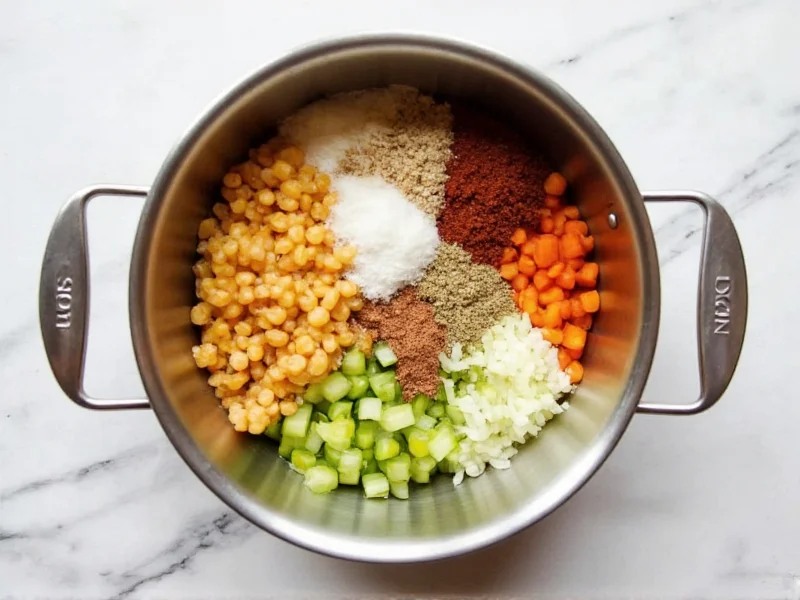Understanding Onion Soup Mix Composition
Onion soup mix serves as a convenient base for soups, gravies, and dips. Understanding its exact composition helps home cooks make informed decisions about what they're adding to their meals. While recipes vary by brand, most commercial onion soup mixes share a core set of ingredients that create that distinctive savory flavor.
Standard Ingredients in Commercial Onion Soup Mix
The foundation of any quality onion soup mix consists of several key components that work together to deliver consistent flavor and texture. Let's examine what you'll typically find in a standard package:
| Primary Ingredient | Percentage Range | Purpose |
|---|---|---|
| Dehydrated Onions | 30-45% | Provides authentic onion flavor and texture |
| Salt | 15-25% | Enhances flavor and acts as preservative |
| Sugar | 5-12% | Counteracts bitterness and balances flavors |
| Cornstarch | 8-15% | Thickening agent for soups and sauces |
| Onion Powder | 5-10% | Intensifies onion flavor profile |
| Garlic Powder | 2-5% | Complements onion flavor with savory notes |
Common Additives and Flavor Enhancers
Beyond the basic ingredients, most commercial onion soup mixes contain several additives that enhance flavor, extend shelf life, and improve consistency. Understanding these components helps when evaluating onion soup mix ingredients list for dietary needs:
- Monosodium Glutamate (MSG) - Present in approximately 70% of commercial mixes, this flavor enhancer creates umami depth
- Maltodextrin - A carbohydrate used as a thickener and flavor carrier, particularly in low-sodium varieties
- Autolyzed Yeast Extract - Natural source of glutamates that provides savory flavor without listing MSG specifically
- Spice Extractives - Concentrated forms of spices that deliver consistent flavor
- Disodium Inosinate and Guanylate - Often used with MSG to boost umami at lower concentrations
- Sodium Caseinate - A milk derivative used as a flavor enhancer in some brands
Brand Variations in Onion Soup Mix Ingredients
Not all onion soup mixes are created equal. Major brands have distinct formulations that cater to different consumer preferences and dietary needs. When examining onion soup mix ingredients list across popular brands, notable differences emerge:
Classic brands like Lipton® Onion Soup Mix contain MSG as a primary flavor enhancer, while newer "homestyle" varieties often replace MSG with autolyzed yeast extract. Organic options typically eliminate artificial additives but may have shorter shelf lives. Gluten-free versions substitute cornstarch with alternative thickeners like tapioca starch.
For those seeking onion soup mix nutritional information, it's important to note that sodium content varies significantly—ranging from 300-800mg per serving depending on the brand and formulation. Low-sodium versions typically replace some salt with potassium chloride, which can impart a slightly metallic aftertaste.
Creating Your Own Homemade Onion Soup Mix
If you're concerned about commercial onion soup mix composition or have specific dietary restrictions, making your own homemade onion soup mix recipe offers complete ingredient control. This simple alternative avoids preservatives and allows customization to your taste preferences:
Basic Homemade Onion Soup Mix Recipe
- 1 cup dehydrated minced onions
- 3 tablespoons onion powder
- 2 tablespoons garlic powder
- 2 tablespoons cornstarch or arrowroot powder
- 1½ tablespoons sea salt
- 1 tablespoon sugar or coconut sugar
- 1 teaspoon black pepper
- 1 teaspoon paprika
- ½ teaspoon celery seed
- ¼ teaspoon dried thyme
Mix all ingredients thoroughly and store in an airtight container. This homemade version provides a clean onion soup mix ingredients list without artificial additives, making it ideal for those monitoring their onion soup mix allergens.
Dietary Considerations and Allergens
When evaluating commercial onion soup mix ingredients, several dietary factors warrant attention. Most standard mixes are naturally gluten-free, but some budget brands may use wheat flour as a thickener. Always check labels if you have celiac disease or gluten sensitivity.
For those following a low-FODMAP diet, commercial onion soup mix presents challenges since onions are high in FODMAPs. Some specialty brands now offer garlic-free and onion-free versions using asafoetida (hing) for similar flavor profiles.
Vegans should note that while most onion soup mixes are plant-based, some premium varieties contain dairy derivatives like sodium caseinate. Reading the complete onion soup mix ingredients list is essential for strict dietary adherence.
Practical Usage Tips
Understanding onion soup mix composition helps maximize its culinary potential. When using commercial mixes, consider these professional tips:
- For richer flavor, sauté fresh onions before adding the mix
- Use broth instead of water to activate flavors more effectively
- Add acidic elements like wine or vinegar to balance the saltiness
- For homemade versions, toast the spices briefly to enhance aroma
- Store commercial mixes in airtight containers away from light to preserve flavor
When comparing onion soup mix vs fresh onions, remember that commercial mixes offer convenience but lack the complexity of freshly caramelized onions. For special occasions, consider using half commercial mix and half fresh caramelized onions for the best of both worlds.
Reading Labels for Health-Conscious Choices
As consumers become more ingredient-aware, understanding onion soup mix nutritional information becomes increasingly important. When selecting a commercial product, look beyond the basic onion soup mix ingredients list to consider:
- Sodium content per serving (aim for under 500mg if possible)
- Presence of artificial colors or flavors
- Added sugars beyond what's listed
- Hidden allergens like dairy derivatives
- Whether "natural flavors" might contain problematic components
Organic and specialty brands often provide cleaner formulations, though they typically come at a higher price point. For those monitoring onion soup mix allergens, these premium options frequently offer more transparent labeling practices.











 浙公网安备
33010002000092号
浙公网安备
33010002000092号 浙B2-20120091-4
浙B2-20120091-4